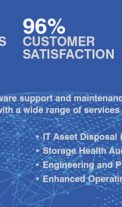At 7Tech a great deal of our work involves the complete installation of an IT infrastructure for office moves, or a complete upgrade of the current technology within the existing location. Choosing the right technology for the client is our first and very important task. Making sure this will future proof the businesses efficiency and provide a stable platform for the business and its teams to flourish in a productive environment is the very first part of our planning process.
Our services include:
- Full office plans including wiring schematics
- Server room installation and all required technology
- Planning service to incorporate kit requirements from server installation, cloud base technology, virtual environments, software and wifi surveys
- Installation of air conditioning systems and fire protection
- A complete equipment procurement service, providing highly effective purchasing power
- Energy management – ensuring you have a low energy usage across your infrastructure
- A complete maintenance programme utilising our MaintenancePro UK wide support service
So that’s our services, but what’s our processes for seamless IT infrastructure installation?
No. 1 - Planning the work utilising a project definition document, which includes:
This will include a project overview, the objectives of the product, assumptions, contingency and risk, migration of the project, organisational roles, estimated duration – all of which are completed ready for a Project Work Plan
No.2 - Create a work plan, which provides the step by step instructions for constructing and delivering the project
This is an expanding document that highlights resources, but estimates the work required to deliver the project, which in turn is expanded to reflect any changes in the project requirements
No. 3 - Define project management procedures
This outlines the resources required and to used to complete the project. Team, issues, scope change, risk, quality and communication. A communication document to establish the expectations of the team
No. 4 - Manage the workplan, monitor the schedule and budgets
Once the complete work plan is in place, the work can begin, but continuous management procedures are in place allowing for the correct execution of the plans
No. 5 - Look for warning signs
A small variance in the agreed schedule can have a negative impact, or if the project grows throughout the duration, this requires recognition so decisions can be made to rectify any inconvenience. Monitoring quality control is part of the process.
No. 6 - Ensuring the client approves scope-change requests
Managing scope is the most important activity alongside the schedule. Many aspects of a project can change and regularly do, so managing these changes and how they impact on the deliverability of a project is important
No. 7 - Guarding against small scope changes
The larger changes are obvious within any IT infrastructure project, but small changes can add up from a cost and time point of view.
No. 8 - Identify project risks up front
No one IT project is the same and as diverse as the clients business itself, so identifying risks can be difficult, but incredibly important where a deadline has been agreed, and to go beyond this deadline could cause issues and unwanted stress for the client
No. 9 - Continued identification of risk
Although any well planned project should have identified a number of risks, changing requirements of a project can bring on new risks, so continuous monitoring is an important part of the process
No. 10 - Resolving issues as quickly as possibly
Every specialist as learnt the hard way, issues that arise need quick resolutions so not to delay the project
With over 20 years of experience delivering advanced IT infrastructure projects, 7Tech uses this experience to plan and effect a project positively. IT infrastructure installation by its very nature is complex, but taking these 10 recommendations as part of our systems and processes has given us superb grounding to deliver quite extensive and complicated projects for many companies throughout the UK and Europe.







